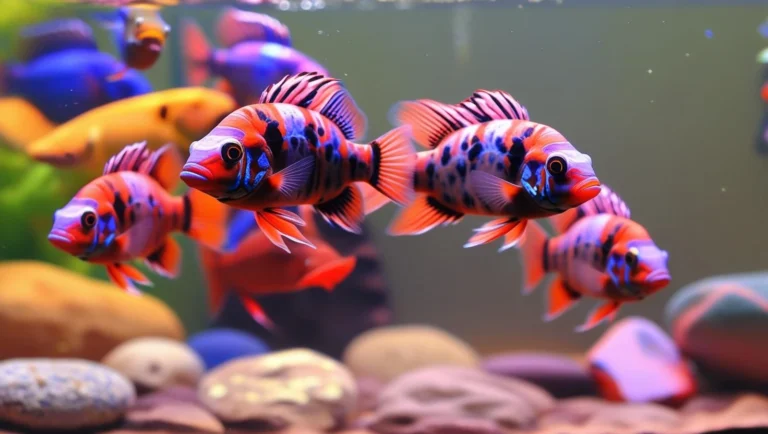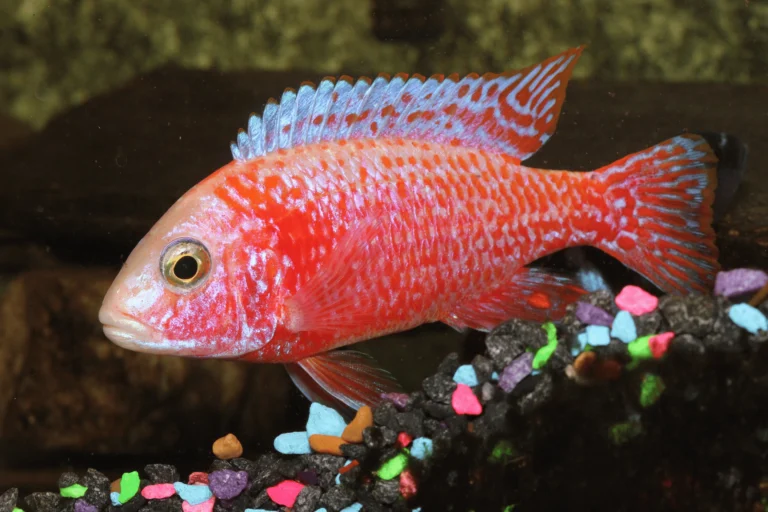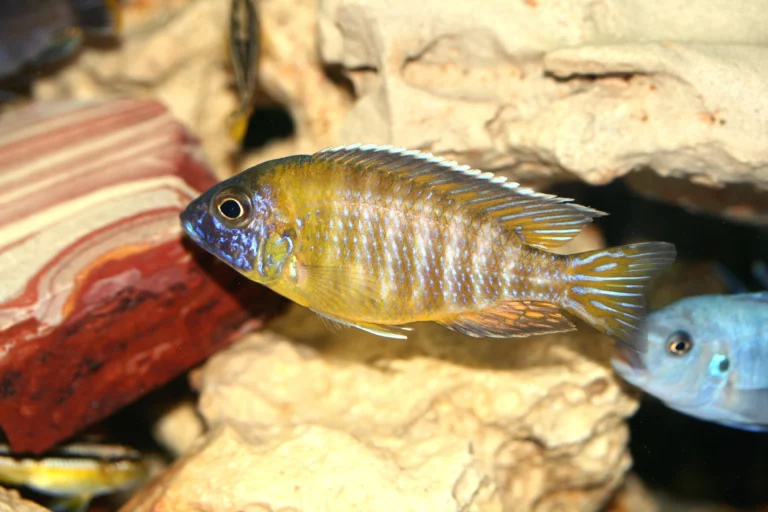Your trusted guide to cichlid care, tank setups, and quality products.

10 Proven Tips for Breeding Peacock Cichlids Successfully
Ready to embark on the exciting journey of breeding peacock cichlids? Our comprehensive guide provides expert tips for successful spawning, from creating the ideal breeding environment to caring for the fry.
Image credit: Canva
Breeding peacock cichlids is a fascinating and rewarding process for any aquarist. These colorful freshwater fish are not only stunning to observe but also bring an added challenge when it comes to reproduction. To successfully breed peacock cichlids, it’s essential to understand their behavior, provide the right environment, and care for both adults and fry properly. This comprehensive guide outlines 10 actionable steps for breeding peacock cichlids with confidence.
At PeacockCichlid.com, we believe in transparency and honesty with our readers. Some of the links in this article are affiliate links, which means we may earn a small commission if you make a purchase through them—at no additional cost to you. These commissions help support our site, allowing us to continue providing expert advice, in-depth guides, and valuable content for Peacock Cichlid enthusiasts like you.
We only recommend products that we trust and believe will be beneficial for your aquarium. Thank you for your support!
1. Understand the Mating Process of Peacock Cichlids
Breeding peacock cichlids starts with understanding their unique mating process. Knowing how these fish behave during courtship and reproduction is crucial for successful spawning.
Male vs. Female Peacock Cichlids
A key step in breeding peacock cichlids is identifying males and females. Males are larger and exhibit more vibrant colors, particularly during the breeding season. Their radiant hues intensify as they prepare to mate, making them easy to distinguish. Females, on the other hand, are smaller, with subdued coloring and a rounder shape when ready to breed. Male peacock cichlids become territorial and aggressive during this time, signaling their readiness to mate. Observing these differences ensures you can select the right breeding pairs.
Courtship Rituals
Male peacock cichlids perform elaborate courtship displays to attract females. These include flaring fins, showing off vivid colors, and performing intricate dances. The male’s movements are both a display of strength and an invitation to the female. Males also prepare breeding sites by clearing flat areas in the substrate or digging shallow pits, creating a suitable location for egg-laying. Observing these behaviors helps determine when your peacock cichlids are ready to breed and allows you to prepare the tank for spawning.
Mouthbrooding: A Unique Breeding Behavior
One of the defining traits of breeding peacock cichlids is their mouthbrooding behavior. After the female lays eggs, she picks them up in her mouth to protect them. She carries the eggs for 21–28 days, providing a safe environment until they hatch. This fascinating behavior minimizes the risk of predation and ensures the fry have the best chance of survival. Understanding this unique aspect of breeding peacock cichlids is essential to providing proper care.
2. Set Up the Perfect Breeding Tank
Creating an ideal breeding environment is a critical step in breeding peacock cichlids. A well-designed tank promotes spawning and reduces stress on the fish.
Tank Size and Environment
For breeding peacock cichlids, use a tank of at least 40–55 gallons for a pair, or larger if housing multiple fish. Providing ample space reduces aggression and territorial disputes. Overcrowding can increase stress levels and disrupt breeding behavior. Use a sand or fine gravel substrate, as males prefer these for creating breeding pits. Incorporate rocks, caves, and other hiding spots to make the environment more comfortable for females and give them places to retreat from aggressive males.
Optimal Water Conditions
Maintaining proper water conditions is vital for breeding peacock cichlids. Aim for a temperature of 78°F–82°F, a pH of 7.8–8.6, and water hardness of 8–12 dGH. These parameters mimic the natural habitat of peacock cichlids in African lakes, encouraging them to spawn. Use water test kits to monitor these parameters consistently, as even slight deviations can affect breeding success.
Tank Layout and Filtration
Arrange the tank with plenty of hiding spots and open areas for courtship displays. Rocks, caves, and plant-like decorations can create a natural environment that mimics the peacock cichlids’ native habitat. Use gentle filtration to keep water quality high without disturbing breeding sites. Regular water changes are essential to maintain pristine conditions. Avoid strong currents, as they can disrupt the delicate balance of the breeding tank.
3. Select a Healthy Breeding Pair
When breeding peacock cichlids, selecting the right pair is key. Choose a vibrant male and several healthy females to reduce stress. A group dynamic helps diffuse the male’s aggression and ensures a higher chance of successful spawning. Look for females with rounded abdomens, as this indicates they are ready to lay eggs. Ensuring both male and female fish are in peak health is crucial for breeding peacock cichlids successfully.
4. Condition the Pair with High-Quality Food
Feeding your peacock cichlids a high-quality diet is crucial for conditioning them for breeding. Provide protein-rich live or frozen foods like bloodworms, brine shrimp, and daphnia. These nutrient-dense options not only prepare the fish for spawning but also enhance the male’s coloration, making him more attractive to females. Include color-enhancing pellets to boost the male’s vibrancy further and stimulate the female’s readiness to spawn. Consistency in feeding and maintaining a balanced diet are essential aspects of breeding peacock cichlids.
5. Manage Aggression During Breeding
Aggression is common when breeding peacock cichlids. To manage this, increase hiding spots or use tank dividers if necessary. Males can become overly dominant, so providing multiple females or using a larger tank can help diffuse their aggression. Adding peaceful dither fish, which act as calming tank mates, can also reduce stress levels and create a more balanced environment. Keeping aggression under control is a critical factor in breeding peacock cichlids successfully.
6. Monitor Mouthbrooding Behavior
During mouthbrooding, female peacock cichlids need special care. Recognizing and supporting this behavior is vital for breeding success.
Recognizing Mouthbrooding Behavior
A female’s throat area will swell slightly as she holds eggs in her mouth. She may become less active, hide more often, and stop eating. These signs indicate she’s protecting her eggs and should not be disturbed unnecessarily. Observing these changes closely allows you to provide the right care.
Providing Care for the Female
Isolate the female in a separate breeding tank to reduce stress and protect her from aggressive tank mates. Maintain optimal water conditions to support the developing eggs. Offer the female a peaceful environment where she feels secure, as this encourages successful mouthbrooding and fry development.
7. Separate and Protect the Fry
Once the fry are released or stripped from the female’s mouth, transfer them to a separate fry tank to prevent predation. Ensure the fry tank has similar water conditions and gentle filtration to promote growth. A sponge filter is ideal for this purpose, as it prevents the fry from being sucked into the filtration system. Providing a safe environment is crucial for raising healthy fry when breeding peacock cichlids.
8. Feed the Fry for Optimal Growth
Feeding the fry properly is essential for their development. Start with finely crushed flake food, baby brine shrimp, or commercial fry food. Feed them multiple times a day in small amounts to ensure steady growth. Overfeeding can compromise water quality, so monitor feeding carefully and maintain regular water changes to promote fry health.
9. Monitor Growth and Integration
Fry grow rapidly under the right conditions. Once they are large enough to avoid predation, you can introduce them back into the main tank. Gradually acclimate them to the new environment to minimize stress. Monitor their growth and integration with adult fish closely to ensure a smooth transition and avoid any territorial disputes.
10. Overcome Common Challenges
Breeding peacock cichlids comes with challenges, but preparation can help you navigate them successfully.
- Aggressive Males: Increase hiding spots or add more females to reduce stress.
- Female Eating Eggs or Fry: Ensure a peaceful tank environment and maintain water quality.
- Fry Not Growing Properly: Provide adequate food and regular water changes to support growth and development.
Conclusion: A Rewarding Journey
Breeding peacock cichlids is an exciting and fulfilling experience that deepens your connection with these remarkable fish. By following these 10 proven tips, you can create the perfect conditions for successful spawning and enjoy the process of raising healthy fry. Share your experiences with other aquarists to continue learning and growing in this rewarding hobby.
We hope you enjoyed these 10 Proven Tips for Breeding Peacock Cichlids Successfully. To further enhance your breeding expertise and overall care routine, be sure to explore our other related articles on peacochcichlid.com. For example, check out “Breeding Peacock Cichlids: 5 Proven Tips for Massive Success” for even more in-depth breeding strategies, or dive into “10 Proven Tips to Master Peacock Cichlid Diet and Breeding” to learn how nutrition plays a crucial role in your fish’s health and reproduction. If you’re just starting out, our “Peacock Cichlid Care: 7 Powerful Tips for Beginners” offers a great foundation for successful aquarium keeping.
We’re continually updating our content with fresh insights and expert advice, so don’t forget to visit us again and follow our social media channels for the latest tips, community updates, and more. Happy breeding and fish keeping!
FAQ’s
What is the best tank size for breeding peacock cichlids?
A 40–55 gallon tank is ideal for breeding peacock cichlids, as it provides enough space to reduce aggression and support healthy spawning behavior.
How can I identify male and female peacock cichlids?
Males are larger and more vibrantly colored, especially during breeding, while females are smaller and have subdued coloration. Females also appear rounder when ready to breed.
What water conditions are ideal for breeding peacock cichlids?
Maintain a temperature of 78°F–82°F, a pH of 7.8–8.6, and water hardness of 8–12 dGH to replicate their natural habitat and encourage breeding.
How do peacock cichlids care for their eggs?
Peacock cichlids are mouthbrooders, meaning the female carries the eggs in her mouth for 21–28 days to protect them until they hatch.
What should I feed peacock cichlids to prepare them for breeding?
Feed them high-protein live or frozen foods like bloodworms and brine shrimp, along with color-enhancing pellets to condition them and stimulate spawning.
How can I reduce male aggression during breeding?
Provide ample hiding spots, use tank dividers if needed, or add more females to diffuse aggression. Dither fish can also help create a calmer environment.
When should I separate the fry from the main tank?
Separate the fry as soon as they are released or stripped from the female’s mouth to prevent predation by adult fish.
What do peacock cichlid fry eat?
Feed fry finely crushed flake food, baby brine shrimp, or commercial fry food multiple times daily to support steady growth.
Can peacock cichlids breed with other cichlids?
While peacock cichlids can breed with certain other cichlids, it’s best to keep them separate to maintain pure strains and prevent hybridization.
How long does it take for peacock cichlid fry to grow?
With proper care and feeding, fry grow rapidly and can be introduced to the main tank once they are large enough to avoid predation, typically within a few months.



